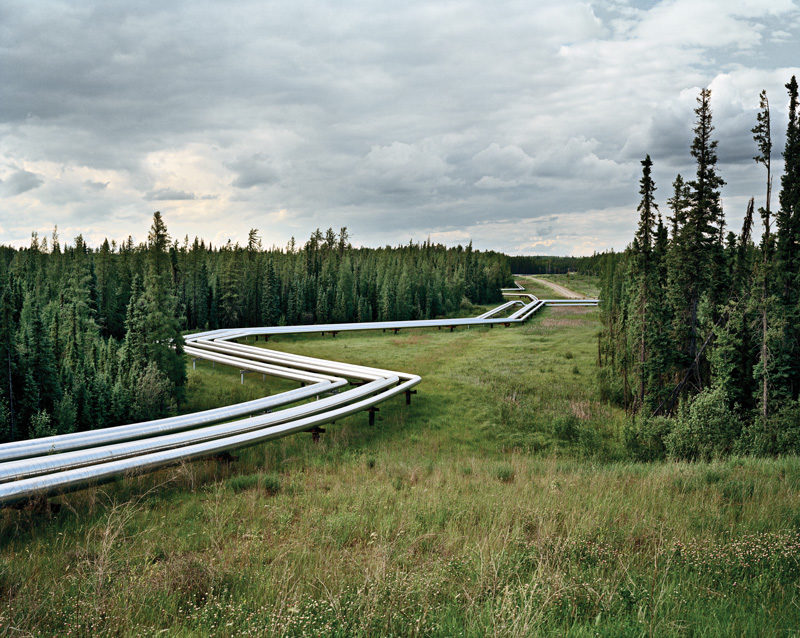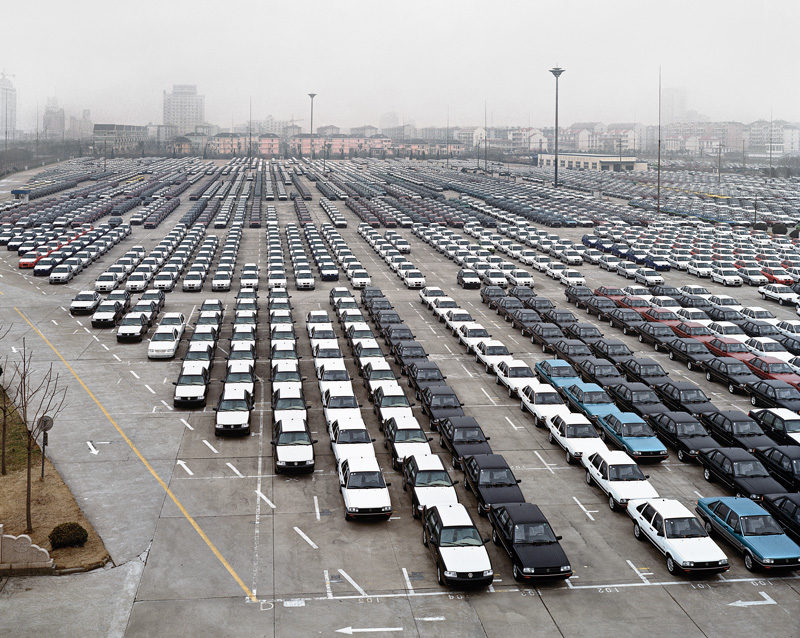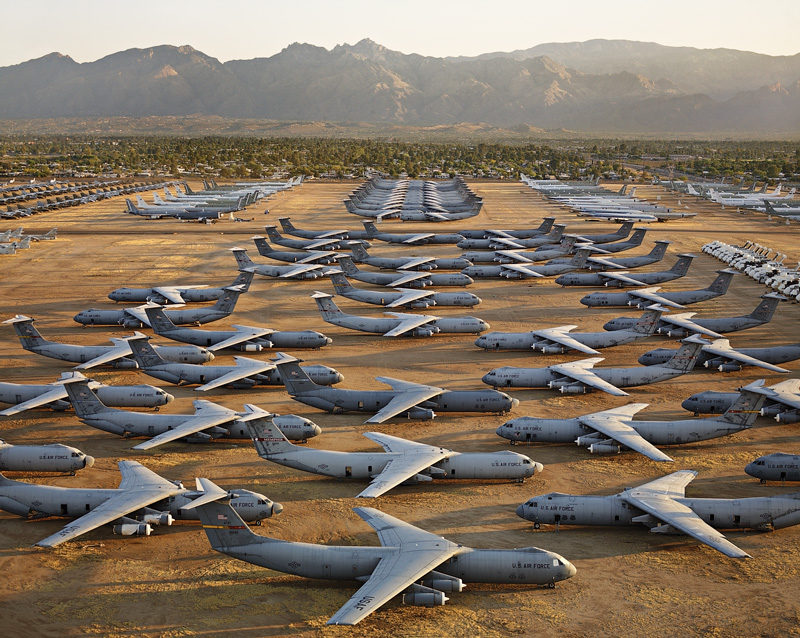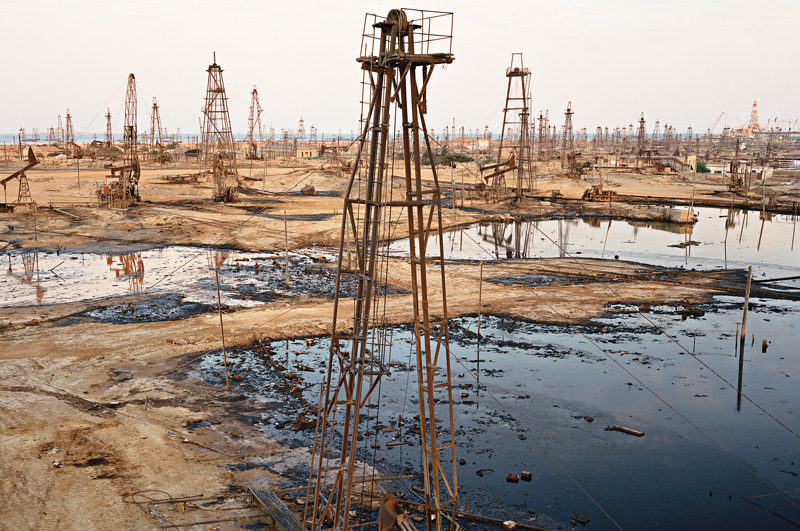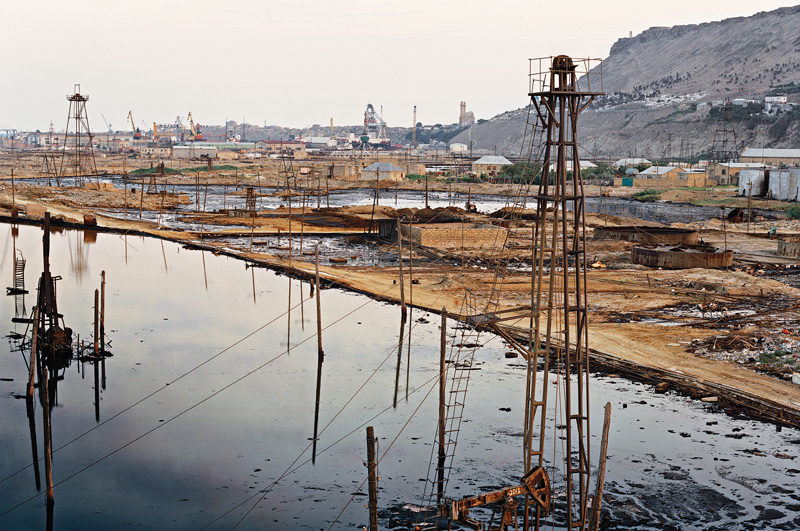[Spring/Summer 2012]
Wanting to show what our natural environment looks like now, Edward Burtynsky began to take pictures of places and sites despoiled by human exploitation. The Oil series brings together all of the images that he has made on the subject over more than ten years. In the most recent version of this often-revised series, which was shown at the McCord Museum, Burtynsky arranged his presentation in groups showing the extraction and processing of the product, the nowabandoned sites of its origin (Detroit), the models of transportation and urban infrastructure of which this energy is the source, and the ecological impact of its waste products on the environment, illustrating the coming exhaustion of the resource.
Looking at monstrous landscapes the pernicious aspect of which is only magnified by the sumptuous colours and rendering of the light. And so, we feel strange when we look at these images. They project a beauty, an aesthetic quality that heightens the critical – anxiously critical – examination that we make of them.
It is difficult not to compare this series to the recent exhibition at the Canada Science and Technology Museum in Ottawa, titled “Energy: The Power to Choose.” For the organization of this exhibition, an advisory committee was formed chaired by the director of public affairs of Imperial Oil, which contributed $600,000 to the event. Although the museum stated that it had the last word on the nature and tone of the exhibition, a number of e-mails showed that the Imperial Oil director in fact intervened repeatedly in the process, making recommendations many of which were adopted by the organizers. Clearly, this kind of manipulation could not fail to nettle the ethical fibre of any taxpayer. In addition, certain of the statements made in the texts accompanying that exhibition have already been denounced by ecology groups as being clearly false.
At first glance, Burtynsky’s position seems less ideologically and politically oriented. He is content, he states, with the act of showing, and he has always resisted the temptation to give a political slant to his presentations. His images are on the order of observation, not denunciation. But it seemed absurd to him, and this gave rise to his early motivation, to continue to show a glossy version of a natural environment, when this environment increasingly bears the marks of major transformations caused by the economic activities of extraction, processing, and use of natural resources. In short, continuing to portray bucolic, rural, and idyllic natural beauty would amount to prevarication and mystification. Burtynsky therefore made a commitment to travel the world looking for these sites in transformation.
The demonstration is masterful. From sites of extraction of raw materials – oil fields and oil sands operations – to dumps piled pell-mell with tires, engine parts, and skeletons of airplanes, the tangles of the expressways that shape our cities, and the recycling of used oil and gigantic rusted ships by impoverished populations who are exposed to contamination, fumes, and illness, anything goes. Burtynsky’s work is done in an almost taxonomic way, systematically retracing the path from extraction of the fossil fuel to the effects of its consumption and the consequences of the waste produced. Thus, on the one hand, there is the damage that extraction inflicts on the environment, what its consumption provokes in terms of modifications to the ecosystem and environment; on the other hand, there is how its residues shape the dangerous conditions for the people who live with them, and then die from them.
Of course, Burtynsky isn’t preaching, but, given what he shows and how he shows it, it amounts to the same thing! The images speak for themselves, he would no doubt say; there’s no need to add anything. Thus, seeing his demonstration, we walk around, stunned, looking at monstrous landscapes the pernicious aspect of which is only magnified by the sumptuous colours and rendering of the light. And so, we feel strange when we look at these images. They project a beauty, an aesthetic quality that heightens the critical – anxiously critical – examination that we make of them.
We thus experience a sort of paradox that sets aesthetics and ethics in opposition. Before us are displayed and deployed the marks of an insistent aestheticism. Then, recognizing what is in the image and what is in question, we are forced back into the net of an ethical judgment of denial. In either case, through the choice of subject, the size of the images, the frontal compositions with extended horizons and in medium shots overloading the image and suggesting disorder and heaping, Burtynsky creates works that refer to the landscape, and to the experience of the beautiful that form its natural complement. We see many images with wide angles, receding sightlines, and a carefully orchestrated ordering of persons and things, as well as medium shots plunging us into the heart of the subject, along the lines and metallic tubes of refineries and into the clutter of used-parts cemeteries – all respecting the expected rules of composition. Distanced from the subjects or brought close to them, we are at leisure to scrutinize and study what is stated here as an exhibition that is also a demonstration.
Because Burtynsky adopts a certain presentation strategy for these cultural objects, we come to apprehend their representation as manifestations of the beautiful, with which they share, it is true, some codes and idiosyncrasies. Immanuel Kant wrote, “The beautiful is that which, apart from concepts, is represented as the Object of universal delight.” If the beautiful is an intermediary between perceptivity and understanding, we must believe that the general tessitura of the images engages our perceptivity in a pleasant way, whereas it quickly turns out that their content staggers our understanding. Here, it is a question of a set order of things and what happens when our unbridled consumption of fossil fuels overturns that order. Burtynsky thus finds himself stimulating our perceptions to the maximum so that our comprehension of what is at work here will lead us to pure and simple consternation. The aestheticizing overload, the extremely realistic rendering, the vibrant colours, and the occupation of all planes and areas of the image are definitely intended to make the ethical shock even greater. Maximum aestheticism for maximum comprehension. We register the signs of beauty, but in the end we are taken aback at the primary cause of this overload. We have, or soon will, become the Mad Maxes of a world that we thought was purely imaginary but that exists a stone’s throw from where we are. These images are those of our present: they show everything that we need to be able to heat ourselves, move ourselves, and surround ourselves with objects. Thanks to these things, we can freely exert our power and our desire to consume. Thus, all of this beauty is the expression of everything to which we owe our way of life – and of the price that others are paying for it, and that we, too, will one day pay.
Translated by Käthe Roth
Edward Burtynsky, whose parents were from the Ukraine, was born in St. Catharines, Ontario, in 1955, and earned a degree in applied arts from Ryerson University. In 1985, he founded Toronto Image Works, which offers services and training to the city’s art community. His early exhibitions featured pictures of the General Motors plant in his hometown and formed a basis for his entire photographic corpus. Exploring the link between industry and nature, Burtynsky finds beauty and humanity in the most improbable places. His photographs are in the collections of more than fifty museums around the world. www.edwardburtynsky.com
Sylvain Campeau has contributed to numerous Canadian and European magazines (Ciel variable, etc, Photovision, and Papal Alpha). As a curator, he has organized thirty exhibitions presented in Canada and abroad. He is also the author of the essay Chambre obscure: photographie et installation and of four poetry collections.


